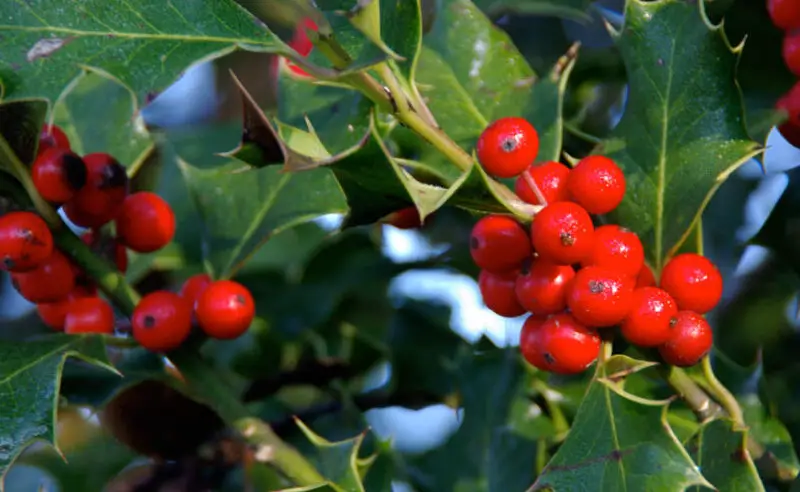Winter is, for our holly, its glorious period. It seems invulnerable with its dark green foliage, enhanced by bright berries of a beautiful scarlet red. The common holly is found throughout Europe, except in the far north and western Asia. It likes acid soils and humid regions.
It forms the shrub layer in beech woods and mixed forests. Its trunk is stocky, often branched near the base and covered with bark first smooth and yellowish green and then gray and slightly striated. The crown is oval and dense, rather narrow at the top. A dioecious tree, it only bears fruit when the male feet grow close to the female feet. However, beware of its berries which are poisonous.
Contents
Planting holly
If holly is found in all regions it is because it is capable of adapting to all types of climates. It tolerates all types of soil and is resistant to most weather conditions.
It is preferable to plant in the fall to promote rooting but you can plant in the winter as well, until spring by avoiding frost periods.
If you plant in the spring, plan a more regular watering the first year after planting.
- The holly tolerates the sun but prefers the shade provided by the trees in the woods and forests.
- It likes a certain humidity and freshness in the soil.
- Regular watering in spring and summer is important in the first year after planting.
If you wish to plant a holly in full sun, prefer varieties with variegated foliage.
An ornamental plant for winter
Holly, which is commonly grown in gardens for its ornamental qualities, can also be used to form semi-defensive hedges.
This shrub, whose growth is quite slow, can reach a height of 6.5 to 26 feets depending on the species.
It generally appreciates a shady or semi-shady exposure, even if the variegated foliage varieties can withstand strong sunlight.
It develops mainly in acidic soils, but also accepts calcareous soils.
It is a relatively hardy plant, which can withstand occasional frosts up to 5°F.
The best time for planting and repotting is autumn in areas with a mild climate and spring everywhere else.
Holly is a dioecious species, i.e. with separate male and female plants.
To obtain beautiful red fruits, it is therefore necessary to plant one female and one male plant nearby.
The fruits appear exclusively on the female plants in September and persist all winter long.
Maintenance and multiplication
This shrub can be subject to attacks by aphids or scale insects on the foliage.
As far as pruning is concerned, it is possible to cut it down with pruning shears to give it an aesthetic shape, in June and September.
Holly is easily pruned and can even become invasive.
Its multiplication can also be done by sowing or by cutting in winter, using cuttings hormones.
Maintenance of the holly according to the seasons
Maintaining the holly in the spring
– Prune the holly once in March each year to keep the shrub looking good: shorten the branches by 8 inches. On older subjects, remove misplaced branches, dead branches, and branches that cross each other. Deciduous holly will bear fruit, and evergreen holly the following year.
– To have fruit, you need one male and one female;
– Apply fertilizer, such as crushed horn.
Summer holly maintenance
– Water in hot, dry weather;
– Keep cool at the base of the shrub by mulching.
Fall holly maintenance
– Remove dead leaves that fall on the foliage of the shrub.
– Weed at its foot.
Winter holly maintenance
– Be careful, the fruits are slightly toxic.
– Don’t leave snow on the branches, sweep it off before its weight breaks them.
Pruning of holly
For holly, no pruning is necessary, especially since the growth of holly is relatively slow.
You can nevertheless give it the shape you want without any problem.
- The best time to prune holly is at the end of winter.
- Do not prune in the fall or you will not enjoy its pretty red berries.
- Use gloves because its prickly can injure you.
- Avoid composting holly because its leaves are very tough and will take a long time to compost.
Summary
Its red berries remind us of the magic of Christmas and the amazed eyes of children. It is moreover the plant most often represented to illustrate the festive season.
But holly is interesting in the garden all year round. Persistent, resistant, it withstands the cold, sea spray and pollution. Dark green or variegated, red, orange or yellow berries.
Its growth is rather slow, hardly more than 6 to 9 inches per year. Depending on the variety, the adult height varies from 3.2 feets to more than 65 feets! The best period for planting and repotting is autumn in regions with a mild climate and spring everywhere else, it is also possible to plant it in winter, although more difficult!









